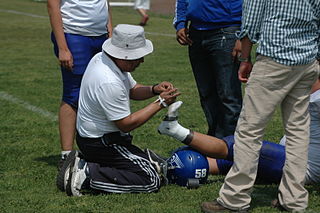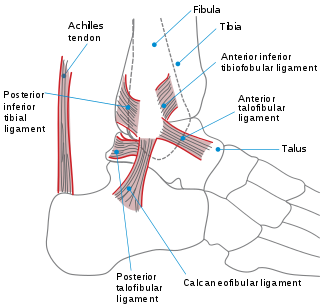
Sports injuries are injuries that occur during sport, athletic activities, or exercising. In the United States, there are approximately 30 million teenagers and children who participate in some form of organized sport. Of those, about three million athletes age 14 years and under experience a sports injury annually. According to a study performed at Stanford University, 21 percent of the injuries observed in elite college athletes caused the athlete to miss at least one day of sport, and approximately 77 percent of these injuries involved the knee, lower leg, ankle, or foot. In addition to those sport injuries, the leading cause of death related to sports injuries is traumatic head or neck occurrences.

Exercise is intentional physical activity to enhance or maintain fitness and overall health.
Delayed onset muscle soreness (DOMS) is the pain and stiffness felt in muscles after unaccustomed or strenuous exercise. The soreness is felt most strongly 24 to 72 hours after the exercise. It is thought to be caused by eccentric (lengthening) exercise, which causes small-scale damage (microtrauma) to the muscle fibers. After such exercise, the muscle adapts rapidly to prevent muscle damage, and thereby soreness, if the exercise is repeated.

Stretching is a form of physical exercise in which a specific muscle or tendon is deliberately expanded and flexed in order to improve the muscle's felt elasticity and achieve comfortable muscle tone. The result is a feeling of increased muscle control, flexibility, and range of motion. Stretching is also used therapeutically to alleviate cramps and to improve function in daily activities by increasing range of motion.

Cryotherapy, sometimes known as cold therapy, is the local or general use of low temperatures in medical therapy. Cryotherapy may be used to treat a variety of tissue lesions. The most prominent use of the term refers to the surgical treatment, specifically known as cryosurgery or cryoablation. Cryosurgery is the application of extremely low temperatures to destroy abnormal or diseased tissue and is used most commonly to treat skin conditions.
Overtraining occurs when a person exceeds their body's ability to recover from strenuous exercise. Overtraining can be described as a point where a person may have a decrease in performance and plateauing as a result of failure to consistently perform at a certain level or training load; a load which exceeds their recovery capacity. People who are overtrained cease making progress, and can even begin to lose strength and fitness. Overtraining is also known as chronic fatigue, burnout and overstress in athletes. It is suggested that there are different variations of overtraining, firstly monotonous program over training suggest that repetition of the same movement such as certain weight lifting and baseball batting can cause performance plateau due to an adaption of the central nervous system which results from a lack of stimulation. A second example of overtraining is described as chronic overwork type training where the subject may be training with too high intensity or high volume and not allowing sufficient recovery time for the body. Up to 10% of elite endurance athletes and 10% of American college swimmers are affected by overtraining syndrome.

Strength training, also known as weight training or resistance training, involves the performance of physical exercises that are designed to improve strength and endurance. It is often associated with the lifting of weights. It can also incorporate a variety of training techniques such as bodyweight exercises, isometrics, and plyometrics.
Manual therapy, or manipulative therapy, is a physical treatment primarily used by physical therapists, physiotherapists, occupational therapists to treat musculoskeletal pain and disability; it mostly includes kneading and manipulation of muscles, joint mobilization and joint manipulation. It is also used by Rolfers, massage therapists, athletic trainers, osteopaths, and physicians.

Plyometrics, also known as jump training or plyos, are exercises in which muscles exert maximum force in short intervals of time, with the goal of increasing power (speed-strength). This training focuses on learning to move from a muscle extension to a contraction in a rapid or "explosive" manner, such as in specialized repeated jumping. Plyometrics are primarily used by athletes, especially martial artists, sprinters and high jumpers, to improve performance, and are used in the fitness field to a much lesser degree.

Cooling down is the transition from intense physical activity to a more typical activity level. Depending on the intensity of the exercise, cooling down after a workout method, such as intense weightlifting, can involve a slow jog or walk.

Patellar tendinitis, also known as jumper's knee, is an overuse injury of the tendon that straightens the knee. Symptoms include pain in the front of the knee. Typically the pain and tenderness is at the lower part of the kneecap, though the upper part may also be affected. Generally there is no pain when the person is at rest. Complications may include patellar tendon rupture.

A sprained ankle is an injury where sprain occurs on one or more ligaments of the ankle. It is the most commonly occurring injury in sports, mainly in ball sports such as basketball, volleyball, football, and tennis.
General fitness training works towards broad goals of overall health and well-being, rather than narrow goals of sport competition, larger muscles or concerns over appearance. A regular moderate workout regimen and healthy diet can improve general appearance markers of good health such as muscle tone, healthy skin, hair and nails, while preventing age or lifestyle-related reductions in health and the series of heart and organ failures that accompany inactivity and poor diet.

The acetabular labrum is a fibrocartilaginous ring which surrounds the circumference of the acetabulum of the hip, deepening the acetabulum. The labrum is attached onto the bony rim and transverse acetabular ligament. It is triangular in cross-section.

A pull-up is an upper-body strength exercise. The pull-up is a closed-chain movement where the body is suspended by the hands, gripping a bar or other implement at a distance typically wider than shoulder-width, and pulled up. As this happens, the elbows flex and the shoulders adduct and extend to bring the elbows to the torso.
The interplay of exercise and music has long been discussed, crossing the disciplines of biomechanics, neurology, physiology, and sport psychology. Research and experimentation on the relation between music and exercise dates back to the early 1900s, when investigator Leonard Ayres found that cyclists pedaled faster in the presence of a band and music, as opposed to when it was silent. Since then, hundreds of studies have been conducted on both the physiological and psychological relationship between music and physical activity, with a number of clear cut relationships and trends emerging. Exercise and music involves the use of music before, during, and/or after performing a physical activity. Listening to music while exercising is done to improve aspects of exercise, such as strength output, exercise duration, and motivation. The use of music during exercise can provide physiological benefits as well as psychological benefits.
Eccentric training is a type of strength training that involves using the target muscles to control weight as it moves in a downward motion. This type of training can help build muscle, improve athletic performance, and reduce the risk of injury. An eccentric contraction is the motion of an active muscle while it is lengthening under load. Eccentric training is repetitively doing eccentric muscle contractions. For example, in a biceps curl the action of lowering the dumbbell back down from the lift is the eccentric phase of that exercise – as long as the dumbbell is lowered slowly rather than letting it drop.
Health issues of athletics concern the health and well-being of athletes who participate in an organized sport. If athletes are physically and mentally underdeveloped, they are susceptible to mental or physical problems. Athletes trying to improve their performance in sports can harm themselves by overtraining, adopting eating habits that damage them physically or psychologically, and using steroids or supplements.

A foam roller is a lightweight, cylindrical tube of compressed foam. It may be used for many reasons, including increasing flexibility, reducing soreness, and eliminating muscle knots. Foam rolling is a method of self-myofascial release. Foam rollers have a short term positive impact in the range of motion of joints, but long term performance or range of motion benefits are unknown. Combining foam rolling and stretching does not cause a significant impact in range of motion compared to only foam rolling or stretching, but does have a superior effect in performance only if stretching is done after foam rolling. A 2021 analysis of studies concluded that "evidence seems to justify the widespread use of foam rolling as a warm-up activity rather than a recovery tool" while arguing that post exercise or recovery rolling reduced muscle pain perception. A 2019 review concluded that 90 seconds of foam rolling per muscle group may be the minimum needed to achieve a reduction in muscle pain or soreness in the short term but that there is insufficient evidence for the optimal amount.
Nerve glide, also known as nerve flossing or nerve stretching, is an exercise that stretches nerves. It facilitates the smooth and regular movement of peripheral nerves in the body. It allows the nerve to glide freely along with the movement of the joint and relax the nerve from compression. Nerve gliding cannot proceed with injuries or inflammations as the nerve is trapped by the tissue surrounding the nerve near the joint. Thus, nerve gliding exercise is widely used in rehabilitation programs and during the post-surgical period.















